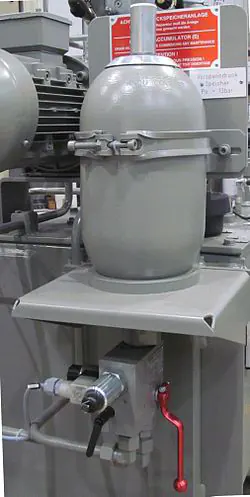Hydro- Pneumatic Accumulators
What are Accumulators?
Mechanical engineers use accumulators to store pressure energy in hydraulic systems. For most practical situations, mineral oil used in most hydraulic systems is incompressible. Therefore, engineers use the compressibility of a gas such as nitrogen to accumulate the hydraulic fluid.
Most accumulators consist of a spherical cylinder. They have a connection at one end for the hydraulic fluid and a connection at the other end for the gas. Accumulators keep the gas and hydraulic fluid apart using different methods. This consists of either a piston, diaphragm, or bladder made from elastomer that is a flexible elastic material.
There are various reasons why hydraulic systems use accumulators. These especially include energy accumulation, hydraulic fluid leakage compensation, shock absorption or as a damping element.
Calculate size of Accumulator
Use the gas law to calculate the correct size of accumulator for any application. If the temperature remains constant, use a slightly modified version of Boyle’s Law, as shown:
Because there are two limiting values for the change in gas conditions, the n value included in the equation. The first is Isothermal, when the gas change takes place very slowly. This allows complete exchange of heat between the gas and its surroundings. In this condition, n = 1. The second is Adiabatic, when the gas change is very rapid and there is no exchange of heat. In this condition, n = 1.4.
The variables in the formula represent different volumes and pressures of gas and hydraulic fluid considered.
V1 = Maximum gas volume of the accumulator, obtained from the manufacturer’s catalogue by estimating which size of accumulator is required.
V2 = The gas volume at P2
V3 = The gas volume at P3
P1 = The pre-charge pressure of the gas. For energy accumulation, this should be about 90% of P2
P2 = The minimum system pressure required for the hydraulic fluid
P3 = The maximum operating pressure, somewhere between P2 and the maximum pump pressure of the hydraulic system, found by trial and error. The ratio between P1 and P3 should not exceed 4:1
To demonstrate how this works, I have created a calculation sheet that shows how to calculate the hydraulic fluid available from a specified accumulator. Click on the image to display the calculation sheet.




